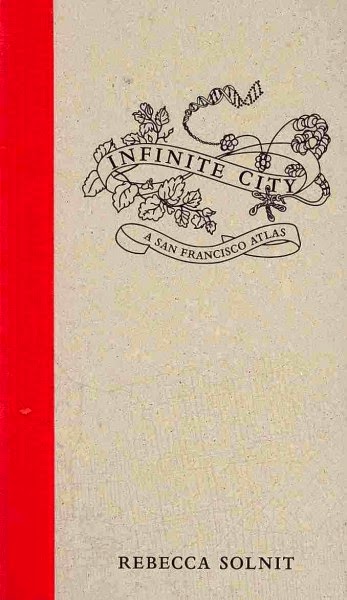~Rebecca Solnit
Author, activist, and historian Rebecca Solnit, along with cartographers, designers, researchers, and teams of artists and writers, is putting out a series of city atlases though the University of California Press. The first two atlases explored San Francisco and New Orleans, and the third will focus on New York City. But, be warned - these are not your traditional atlases. Solnit's atlas places an emphasis on the cultural history of the city, and her rendering is admittedly "modest and deeply arbitrary". As Solnit explains "...a big part of my writing has been to try to describe and value those things that are not quantifiable, commodifiable, controllable: epiphanies, awareness, those beautiful moments when people come together as civil society, whether to pick up after a disaster or overthrow a disastrous regime, beauty itself, and the pleasures that don’t get named much."
In Solnit's atlases, maps, rather than just showing city streets and traditional cultural landmarks (museums, etc.), are a mashup of traditional maps, with varying takes on the topography of the city, and cultural history. The "Cinema City" map in Infinite City: A San Francisco Atlas, for example, shows the reader locations important to Eadweard Muybridge (a photographer who helped create the earliest technology of moving pictures) and to Alfred Hitchcock and his film Vertigo; you can also find the locations of "1958 movie theaters, surviving" and "1958 movie theaters, gone".
Maps are matched with essays on the topic the map explores. Map 9 in Unfathomable City: A New Orleans Atlas is titled "Sugar Heaven and Sugar Hell: Pleasures and Brutalities of a Commodity" - New Orleans is famous for sweet treats such as pralines and beignets. The map shows antebellum sites (e.g. where Jesuit missionaries raised sugar cane in the 1700s), plantation borders, postbellum sites (e.g,. Domino Sugar's Chalmette Refinery), and dialysis centers. The accompanying essay is called "No Sweetness Is Light"; in it, Shirley Thompson talks about "the New Orleans sugar map" and how the craving for sweetness exists alongside the more famous tastes of the city, like fish and hot pepper. It's a brief, often personal essay, touching on diabetes, sugar processing, and slavery.
Both atlases are a pleasure to browse. The maps are coloful and clearly rendered, and there are also some photos and illustrations scattered throughout the book - many vintage, but some from the past few years. You may not be ready to take a tour of San Francisco or New Orleans after you read these atlases, but we think you will have a good sense of place, and a feel for what lies beneath the city's veneer.
You can find both Solnit's atlases in the ABC Library catalog:
The book offers this description of itself on the title page: "Of principal landmarks and treasures of the region, including butterfly species, queer sites, murders, coffee, water, power, contingent identities, social types, libraries, early-morning bars, the lost labor landscape of 1960, and the monumental Monterey cypresses of San Francisco; of indigenous place names, women environmentalists, toxins, food sites, right-wing organizations, World War II shipyards, Zen Buddhist centers, salmon migration, and musical histories of the Bay Area; with details of cultural geographies of the Mission District, the Fillmore's culture wars and metamorphoses, the racial discourses of United Nations Plaza, the South of Market world that redevelopment devoured, and other significant phenomena, vanished and extant."
Maps include: Green Women: Open Spaces and Their Champions; Truth to Power: Race and Justice in the City's Heart; Poison/Palate: The Bay Area in Your Body; Tribes of San Francisco: Their Comings and Goings; The World in a Cup: Coffee Economics and Ecologies.
co-authored with Rebecca Snedeker
Potential readers take note, this book is: "Being an atlas in twenty-two maps and nearly that many essays about the city that is at the bottom of the Mississippi drainage of the interior of the North American continent and at the top of the Gulf of Mexico and at the center of the American unconscious, the small mortal city that is the immortal wellspring of much popular music around the world, a city not quite three hundred years old, half of that an era of slavery, all of that an era of striving for freedom; of segregation and mixing; of crime and corruption in secret and of the confident collective celebration in the streets that is their opposite; of wildlife flying over and oil pipelines cutting through; of complicated stories, not all of them black and white;of various heroines, some heroes; of unfinished tasks and interesting possibilities; a city resting on the pillowy softness of river-delivered muck, mud, and sometimes the hard ground of disputed memory; to say nothing of crawfish boils and the sweet loud sounds of brass bands."
Maps include: Oil and Water: Extracting Petroleum, Exterminating Nature; ¡Bananas!; Snakes and Ladders: What Rose Up, What Fell Down During Hurricane Katrina; The Line-up: Live Oak Corridors and Carnival Parade Routes.
Do these atlases inspire you, as Rebecca Solnit suggests, to "pay close enough attention and move daringly enough through the city [so you] encounter difference, mystery, the unexpected, the tender and desperate little moments of strangers passing by, [and] come to know the rhythms and rites of the city and some of its secrets, and know, too, that there are more secrets than anyone can ever know" in your own town?

No comments:
Post a Comment